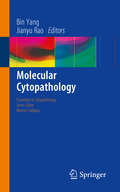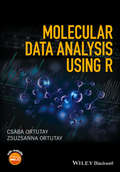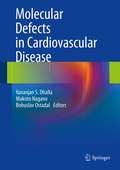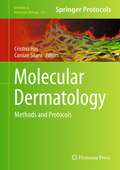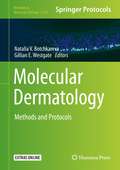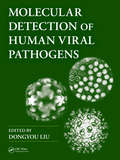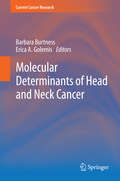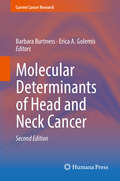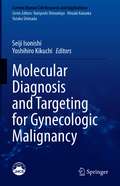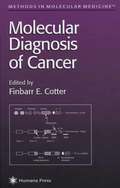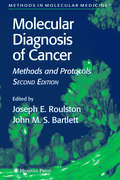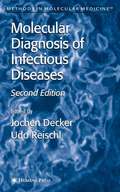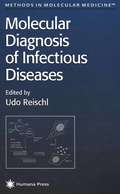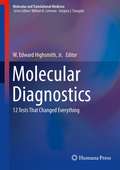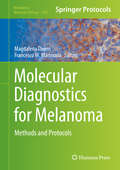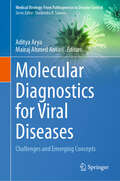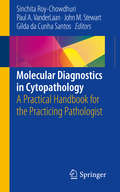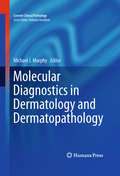- Table View
- List View
Molecular Cytopathology
by Bin Yang Jianyu RaoThis book reviews the current applications of molecular tools in cytopathology and provides a concise handbook for those who provide care in this era of personalized medicine. Specifically, the text provides a comprehensive and concise review of the emerging molecular tests available clinically in different subspecialities of diagnostic pathology. It reviews the current data of molecular testing already applied in cytopathology, discusses some of the biomarkers with potential utility in cytopathology in the near future and reviews the technical challenges in applying and validating molecular tools in liquid-based cytologic materials. Molecular Cytopathology will serve as a valuable resource for cytopathologists, cytotechnologists, pathology trainees, and clinicians with an interest in molecular applications in cytopathology.
Molecular Data Analysis Using R
by Csaba Ortutay Zsuzsanna OrtutayThis book addresses the difficulties experienced by wet lab researchers with the statistical analysis of molecular biology related data. The authors explain how to use R and Bioconductor for the analysis of experimental data in the field of molecular biology. The content is based upon two university courses for bioinformatics and experimental biology students (Biological Data Analysis with R and High-throughput Data Analysis with R). The material is divided into chapters based upon the experimental methods used in the laboratories. Key features include:• Broad appeal--the authors target their material to researchers in several levels, ensuring that the basics are always covered.• First book to explain how to use R and Bioconductor for the analysis of several types of experimental data in the field of molecular biology.• Focuses on R and Bioconductor, which are widely used for data analysis. One great benefit of R and Bioconductor is that there is a vast user community and very active discussion in place, in addition to the practice of sharing codes. Further, R is the platform for implementing new analysis approaches, therefore novel methods are available early for R users.
Molecular Defects in Cardiovascular Disease
by Bohuslav Ostadal Makoto Nagano Naranjan S. DhallaMolecular Defects in Cardiovascular Disease provides an in-depth discussion of the molecular mechanisms underlying the genesis of cardiovascular defects and the implications this has on current and emerging targeted therapeutics. Divided into three sections, this book covers the scientific foundations of our present understanding as well as the array of clinical manifestations and their treatment. The first section covers Molecular Mechanisms of Heart Disease, with discussion of the development of cardiovascular dysfunction. The remaining two sections provide a more clinical focus. The second, Cardiac Hypertrophy and Heart Failure deals with metabolic derangements, Ca2+ handling, and subcellular remodeling. It illustrates the wide variety of molecular defects which may serve as targets associated with the transition from cardiac hypertrophy to advanced heart failure. The third section, Hypertension and Diabetes, provides molecular rationale for the pathogenesis of hypertension and diabetic cardiomyopathy, as well as highlighting the importance of hormones toward this end. A necessary resource for clinicians and researchers, this book elucidates the experimental basis of the practice of cardiology. It is the culmination of our advances in the understanding of cardiovascular molecular biology and a blueprint for the efficacious use of targeted therapies.
Molecular Dermatology
by Cristina Has Cassian SitaruThe sustained skin research efforts over the past decades has led to the accumulation of a significant collection of information on skin structure and physiology as well as on the pathogenesis of cutaneous diseases. In Molecular Dermatology: Methods and Protocols, leading experts in the field provide a collection of state-of-the-art reliable protocols covering a wide spectrum of techniques and experimental models, specific molecular assays and disease models, as well as overviews of diagnostic and research areas relevant to molecular dermatology. As a volume in the highly successful Methods in Molecular BiologyTM series, chapters include introductions to their respective topics, lists of the necessary materials and reagents, step-by-step, readily reproducible laboratory protocols, and tips on troubleshooting and avoiding known pitfalls. Comprehensive and authoritative, Molecular Dermatology: Methods and Protocols emphasizes the vital importance of skin research and collects the methodologies necessary to aid scientists in moving forward in this valuable field.
Molecular Dermatology: Methods and Protocols (Methods in Molecular Biology #2154)
by Natalia V. Botchkareva Gillian E. WestgateThis volume delivers the most important laboratory techniques that underlie dermatological investigation, including in situ, in vitro, ex vivo, and in vivo models of skin, its appendages (hair follicles, sebaceous and sweat glands), and immune cells. Also included are unique techniques that unravel epigenetic mechanisms in skin and hair follicle cells, such as gene organization in the nucleus and gene expression regulation by the non-coding transcriptome, which are important recent developments in investigative dermatology. Written for the highly successful Methods in Molecular Biology series, chapters include introductions to their respective topics, lists of the necessary materials and reagents, step-by-step, readily reproducible laboratory protocols, and tips on troubleshooting and avoiding known pitfalls. Authoritative and practical, Molecular Dermatology: Methods and Protocols serves as an essential resource for researchers working in the areas of fundamental as well as applied dermatological science.
Molecular Detection of Animal Viral Pathogens
by Dongyou LiuMolecular Detection of Animal Viral Pathogens presents expert summaries on state-of-the-art diagnostic approaches for major animal viral pathogens, with a particular emphasis on identification and differentiation at the molecular level. Written by specialists in related research areas, each chapter provides a concise overview of an individual virus
Molecular Detection of Human Bacterial Pathogens
by Dongyou LiuAs more original molecular protocols and subsequent modifications are described in the literature, it has become difficult for those not directly involved in the development of these protocols to know which are most appropriate to adopt for accurate identification of bacterial pathogens. Molecular Detection of Human Bacterial Pathogens addresses th
Molecular Detection of Human Fungal Pathogens
by Dongyou LiuThe large number of molecular protocols available creates a dilemma for those attempting to adopt the most appropriate for streamlined identification and detection of fungal pathogens of interest. Molecular Detection of Human Fungal Pathogens provides a reliable and comprehensive resource relating the molecular detection and identification of major
Molecular Detection of Human Parasitic Pathogens
by Dongyou LiuTraditionally, laboratory identification of parasites has relied upon various phenotypic procedures that detect their morphological, biological, and immunological features. Because these procedures tend to be time-consuming and technically demanding, molecular methods based on nucleic acid amplification technologies have been increasingly utilized
Molecular Detection of Human Viral Pathogens
by Dongyou LiuDespite being recognized and fought against over countless centuries, human viral pathogens continue to cause major public health problems worldwide-killing millions of people and costing billions of dollars in medical care and lost productivity each year. With contributions from specialists in their respective areas of viral pathogen research, Mol
Molecular Determinants of Head and Neck Cancer
by Barbara Burtness Erica A. GolemisSquamous cell cancers of the head and neck (SCCHN), also known as head and neck cancers (HNC) encompass malignancies of the oral cavity, larynx, nasopharynx and pharynx, and are diagnosed in over 500,000 patients worldwide each year, accounting for 5% of all malignancies. In the past several years, there have been significant developments in understanding of HNC. It is now recognized that although alcohol and tobacco use has represented the likely predominant cause of SCCHN, the incidence of a second class of SCCHN related to oncogenic human papillomavirus (HPV) infection is increasing, with a four-fold increase in the past 2 decades, and now thought to represent up to 30% of cases. The first effective target for SCCHN, the EGFR-targeting antibody cetuximab, was approved as recently as in 2006; since then, a growing body of research has identified additional signaling pathways as important in disease pathogenesis, and in resistance to treatment. Proteins such as c-Met, Src, and HER2 are emerging as new therapeutic targets, with a considerable ferment in the clinical trial community. As a capstone of research progress, 2011 marked the first reports of high throughput sequencing of SCCHN tumors, with these efforts identifying unexpected players such as Notch as frequent subject of mutation, spawning new hypotheses for future research. This book will be of interest to researchers who are interested in better understanding the biology of head and neck cancers, with the goals of better designing therapies, identifying risk factors, or investigating the molecular basis of the disease.
Molecular Determinants of Head and Neck Cancer (Current Cancer Research)
by Barbara Burtness Erica A. GolemisSquamous cell cancers of the head and neck (SCCHN), also known as head and neck cancers (HNC) encompass malignancies of the oral cavity, larynx, nasopharynx and pharynx, and are diagnosed in over 500,000 patients worldwide each year, accounting for 5% of all malignancies. It is estimated that approximately 50,000 patients develop head and neck cancer annually in the United States, of whom approximately 50% succumb to this cancer. For most cases of SCCHN, treatment is multimodal, often combining surgery or irradiation with chemotherapy; even successfully treated patients frequently experience durable and severe side effects. Improving cure rates and reducing chronic morbidity are urgent clinical needs for head and neck cancer. However, in contrast to cancer types such as breast or prostate that have been much studied and have well-defined biology, until recently, relatively few researchers investigated the molecular basis of HNC, making it difficult to design targeted treatments with better efficacy and less debilitating side effects. This volume will provide an overview of the factors contributing to disease pathogenesis, including the recognition of discrete molecular subtypes with distinct etiology, prognosis, and treatment response. This volume will familiarize the reader with the critical signaling pathways and oncogenic drivers for HNC. It will outline the differences between HPV-positive and HPV-negative disease, and how these differences affect treatment choice and outcome. The book will emphasize developments in the past five years, including the growing understanding of the genomic and epigenomic features of the disease based on analysis of next generation sequencing (NGS) data, and timely topics such as the analysis of HNC stem cell populations, non-coding mRNAs, and inflammatory response. It will address exciting new therapeutic approaches such as the use of immunotherapies to treat HNC patients. Overall, the book will provide the reader with current understanding of the biology and treatment of the disease, and describe timely questions that will guide future research aimed at controlling and curing this disease.
Molecular Determinants of Radiation Response
by Marikki Laiho Theodore L. DeWeeseMolecular Determinants of Radiation Response includes chapters by expert authors who detail the present understanding of key DNA damage response pathways and proteins. The chapters include comprehensive discussions on where and how specific alterations in function of these pathways and proteins result in substantive modifications of cellular response to DNA injury. Given the importance of therapies that induce DNA injury in the management of human disease, this book is timely and relevant for basic and translational researchers, as well as clinicians alike.
Molecular Diagnosis and Targeting for Gynecologic Malignancy (Current Human Cell Research and Applications)
by Seiji Isonishi Yoshihiro KikuchiThis book summarizes the important developments in the field of cancer research, specifically uterine cervical/endometrial cancer and ovarian cancer. It highlights the recent advances in gynecologic cancer, such as next generation models of genetically engineered animal models or cancer cell lines, focusing on their significance for advancing our understanding of gynecologic cancer biology, prevention and treatment, and drug response and resistance. Cancer research in the area of gynecologic tumors has undergone an enormous transformation over the past decade, with a greater understanding of tumor biology, elucidation of novel targets for therapeutic intervention, and better recognition of genetic predisposition syndromes. At the same time, the recent advances in basic cancer research have provided key insights into all aspects of gynecologic cancer biology, including developmental pathways and the impact of lineage plasticity, understanding metastatic progression, uncovering the roles of the tumor microenvironment , exploring tumor evolution, and discovering new therapeutic approaches and mechanisms of drug sensitivity and adaptive response. Molecular Diagnosis and Targeting for Gynecologic Malignancy appeals to investigators, clinicians, residents and postdocs who are curious about new research on gynecologic malignancies. It not only presents basic and translational research, but also explores the generalizability of the evidence covering the interface between basic and clinical science. Furthermore, a number of the topics offer the basis for new ideas that have the potential to advance into the gynecologic malignancies. This book provides readers with state-of-the-art information that will help improve the lives of patients with these challenging diseases.
Molecular Diagnosis of Cancer
by Finbarr CotterLeading clinicians and expert researchers bring together under one cover a comprehensive guide to the newest and most essential molecular techniques-particularly PCR-for diagnosing and monitoring hematological and solid tumors. These distinguished practitioners demonstrate step-by-step the use of PCR, FISH, CGH, Southern analysis, sequencing, and SSCP to assess cancer markers, to detect minimal disease and apoptosis, and to uncover particular translocations, mutations, and deletions. Their readily reproducible results offer physicians and scientists a promising entré into the powerful possibilities of using these techniques to improve the diagnosis, prognosis, and management of cancer.
Molecular Diagnosis of Cancer
by John M. Bartlett Joseph E. RoulstonA diverse collection of readily reproducible methods for use in cancer detection. Highlights include FISH-based methodologies currently used in the diagnosis of solid tumors, the molecular diagnosis of genetic abnormalities by DNA array technologies-including sequence-specific oligonucleotide arrays and CGH arrays-and methodologies directed at the detection of epigenetic events and at quantitative gene expression. The authors apply these novel diagnostic procedures to a broad range of cases taken from cytology, solid tumor pathology, hematology, and rare cell detection, paying special attention to potential future developments and the practical problems of dealing with quality control and accuracy.
Molecular Diagnosis of Infectious Diseases
by Udo Reischl Jochen DeckerThis second edition of a classic laboratory manual describes cutting-edge methods for the protein-based diagnosis of infectious diseases. Explaining the latest developments in genomics, proteomics, bioinformatics, biosensors, high-throughput devices, and recombinant technology, the authors apply these new methodologies successfully to the identification and characterization of valuable diagnostic markers, immunomodulatory components, epitope mapping, the production and purification of recombinant antigens, as well as to diagnostic reagents in immunological assays.
Molecular Diagnosis of Infectious Diseases
by Udo ReischlA comprehensive and up-to-date set of basic and advanced methods that illuminates the principles of molecular diagnostics and allows researchers to establish assay systems tailored to their specific needs. This unique collection has been thoroughly updated and expanded and covers the latest strategies for identifying novel diagnostic markers, epitope mapping, and the production and purification of recombinant antigens and their use as diagnostic reagents in immunological assays. This new edition places significant emphasis on bioinformatics and proteomics and the characterization and modification of proteins. It also includes promising techniques based on recent developments in antibody engineering and on the use of biosensors. Rather than focusing on particular infectious agents, this book focuses on the techniques that can be used and tailored to accomplish any kind of molecular diagnostic application in the clinical laboratory, thus making it an essential book for all laboratory disagnosticians.
Molecular Diagnostics
by Sarah Schumacher Harald SeitzIntegration in Bioanalysis: Technologies for Point-of-Care Testing, by Frank F. Bier, Soeren Schumacher Future of Medicine: Models in Predictive Diagnostics and Personalized Medicine, by Babette Regierer, Valeria Zazzu, Ralf Sudbrak, Alexander Kühn and Hans Lehrach A Highly Versatile Microscope Imaging Technology Platform for the Multiplex Real-Time Detection of Biomolecules and Autoimmune Antibodies, by Stefan Rödiger, Peter Schierack, Alexander Böhm, Jörg Nitschke, Ingo Berger, Ulrike Frömmel, Carsten Schmidt, Mirko Ruhland, Ingolf Schimke, Dirk Roggenbuck, Werner Lehmann, Christian Schröder Platform Technologies for Molecular Diagnostics near the Patient's Bedside, by Soeren Schumacher, Christine Lüdecke, Eva Ehrentreich-Förster, Frank F. Bier Microfluidic Technology for Molecular Diagnostics, by Tom Robinson, Petra S. Dittrich Biosensors for Diagnostic Applications, by Friederike J. Gruhl, Bastian E. Rapp, Kerstin Länge Planar Protein Arrays in Microtiter Plates: Development of a New Format Towards Accurate, Automation-Friendly and Affordable (A3) Diagnostics, by Holger Eickhoff, Arif Malik
Molecular Diagnostics
by Jr. W. Edward HighsmithMolecular Diagnostics: 12 Tests That Changed Everything focuses on specific laboratory tests and emphasizes how the availability of these tests has altered how clinicians treat their patients. Presented as a standard outline, each chapter focuses on a specific molecular test and provides background on the test and its clinical applications. Continuing with some discussion on how the test is done, interpreted, and used clinically, each chapter then concludes with a discussion of how that test has changed the way medicine is practiced with respect to the disease or condition in question. Authored by renowned experts in the field, Molecular Diagnostics: 12 Tests That Changed Everything is a valuable resource for pathologists, pathology residents, laboratory directors, development personnel, lab medicine fellows and those working in the broad area of oncology, infectious disease and genetics.
Molecular Diagnostics for Dermatology
by Gregory A. Hosler Kathleen M. MurphyMolecular diagnostics is an exploding field, and recent advances in our understanding of the molecular basis of disease have provided a platform for the development of new diagnostic tests as well as tests to predict tumor behavior and potential response to targeted therapy. This textbook provides a reference and practical guide to molecular diagnostics for dermatologists and dermatopathologists. It outlines our current understanding of the molecular underpinnings of dermatologic disease, describes the appropriate use of currently available molecular tests, and explains the interpretation of these tests in the context of diagnosis and management. Tests relating to various disorders are covered, including but not confined to melanoma, genodermatoses, and infectious disease. Pitfalls are highlighted and user-friendly algorithmic approaches, presented.
Molecular Diagnostics for Melanoma
by Francesco M. Marincola Magdalena ThurinIn Molecular Diagnostics for Melanoma: Methods and Protocols, expert researchers and clinicians in the field of melanoma provide updated information on biomarkers and assays for diagnosis, prognosis, and assays predicting response to treatment for routine testing. The focus of the volume is on biomarkers with established clinical validity rather than those on early discovery stage. With additional in-depth discussion of the molecular biology and pathology of melanoma, treatment options in adjuvant and metastatic setting, and implications of biomarker testing for clinical management of melanoma patients. Written in the highly successful Methods in Molecular Biology series format, chapters include extensive introductions to their respective topics, lists of the necessary materials and reagents, step-by-step, readily reproducible laboratory protocols, and key tips on troubleshooting and avoiding known pitfalls. Comprehensive and practical, Molecular Diagnostics for Melanoma: Methods and Protocols seeks to provide both clinicians and scientists with technical information and extensive background information on the wide ranging approaches available in the field of diagnostics of melanoma.
Molecular Diagnostics for Viral Diseases: Challenges and Emerging Concepts (Medical Virology: From Pathogenesis to Disease Control)
by Aditya Arya Mairaj Ahmed AnsariThis book provides up-to-date information on the molecular diagnosis of viral diseases, including COVID–19, zika virus, human immunodeficiency virus (HIV), viral hepatitis, meningitis, and human papilloma virus (HPV). It covers global trends, the impact of viruses on society, and the need for molecular diagnostics. Initial chapters include information on popular molecular diagnostic methods and up-to-date strategies like Nucleic Acid Testing (NAT) and immunological methods, with an understanding of the challenges in their development. Further chapters emphasize emerging and next-generation diagnostic tools such as Specific High-sensitivity Enzymatic Reporter un-LOCKing (SHERLOCK), DNA Endonuclease Targeted CRISPR Trans Reporter (DETECTR), and Heating Unextracted Diagnostic Samples to Obliterate Nuclease (HUDSON), which boast a sensitivity of up to attomolar. The book also discusses high-end platforms like QIAsymphony. It is supplemented with illustrations and figures to aid conceptual understanding.The book is relevant for researchers in virology, clinicians involved in the therapy of viral diseases, and professionals in pathology labs interested in learning about advanced molecular diagnostic approaches for viral diseases.
Molecular Diagnostics in Cytopathology: A Practical Handbook for the Practicing Pathologist
by John M. Stewart Sinchita Roy-Chowdhuri Paul A. VanderLaan Gilda Da SantosMolecular diagnostics are increasingly used to help guide targeted therapy in solid organ tumors and hematologic malignancies. A large proportion of molecular testing is performed on limited-volume samples obtained via minimally invasive techniques, such as fine needle aspiration. Increasingly, cytopathologists play an essential role in this process, both in the triage of specimens during rapid on-site evaluation and in the evaluation of archival samples to determine suitability for ancillary testing. Therefore, it is imperative that practicing cytopathologists stay abreast of up-to-date diagnostic, prognostic, and predictive ancillary tests that can be used on limited cytologic material. This is a challenge since the landscape of known genomic alterations is constantly evolving and the subsequent set of testing options is ever expanding.The proposed text will provide a user-friendly quick-reference handbook to serve as a useful resource for practicing pathologists and laboratory personnel dealing with, and interested in, this evolving field of molecular cytopathology. Essential components to be presented include: 1) pre-analytic factors that affect sample selection and evaluation; 2) specimen preparation to maximize confidence in results; 3) interpretation of results; 4) potential limitations; and 5) workflow algorithms. In addition, specific disease specific molecular testing details will be outlined to provide the reader with resources for quick reference. All chapters will be written by experts in their fields and will include the most up-to-date scientific and clinical information.Molecular Diagnostics in Cytopathology will be of value to Cytopathologists, Cytotechnologists, Cytotechnology students, Cytopathology fellows, Surgical pathologists, Pathology residents and fellows, Molecular Pathologists, Molecular pathology fellows, Molecular technologists, as well as Translational researchers with an interest in molecular cytopathology.
Molecular Diagnostics in Dermatology and Dermatopathology
by Michael J. MurphyMolecular Diagnostics in Dermatology and Dermatopathology presents the basics of molecular biology and molecular diagnostic methods most commonly used in the clinical laboratory, with an emphasis on the concepts and testing most relevant to dermatological diseases. Topics include the integration of newer diagnostic and prognostic techniques with 'traditional' histologic approaches, and discussions of regulatory, ethical, legal, economic issues and 'newer' technologies. This important diagnostic tool outlines the clinically relevant uses (i.e.; diagnostic, staging and/or prognostic) applications of these techniques in the field of dermatology. Molecular studies that investigate the pathogenesis of skin diseases will be excluded, unless they also have a direct diagnostic utility. The book will be of interest to practicing pathologists, dermatology and pathology residents, dermatologists, and dermatopathologists.
